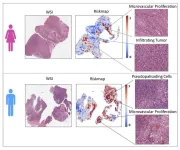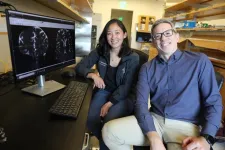(Press-News.org) Imagine a world where your own immune cells are transformed into cancer-fighting superheroes. This is the promise of CAR-T cell therapy, a groundbreaking treatment that’s already saving lives.
In this therapy, patients’ own immune cells are collected, genetically engineered so that they specifically target cancer cells, then returned to the body. The result is a potent new option for battling blood cancers. However, as with any superhero journey, the process of harnessing this incredible power comes with its own set of challenges.
One such hurdle: Current methods for activating T cells don’t resemble closely enough the natural environment in which they interact with another key population of immune cells — a connection crucial for activating T cells and ramping up their ability to fight cancer.
In a recent Nature Nanotechnology study, a UCLA team has unveiled a powerful tool to overcome this limitation. Their new platform combines a flexible material called graphene oxide with antibodies to closely mimic the natural interactions between immune cells. The investigators found that this mimicry shows a high capacity for stimulating T cells to reproduce, while preserving their versatility and potency.
The advance could make CAR-T cell therapy more effective and accessible, while also driving progress for other emerging treatments.
“Our interface bridges the gap between the laboratory and actual conditions inside the body, allowing us to gain insights much more relevant to real-world biological processes,” said co-corresponding author Yu Huang, the Traugott and Dorothea Frederking Professor of Engineering at the UCLA Samueli School of Engineering and a member of the California NanoSystems Institute at UCLA (CNSI). “Beyond T cell therapies, we can apply this technology to a variety of fields including tissue engineering and regenerative medicine.”
The researchers anchored two specific antibodies onto graphene oxide. Over 12 days, their platform facilitated a 100-fold-plus increase in T cell expansion in a culture of blood cells. The technology also enhanced the efficiency of engineering immune cells, leading to a five-fold increase in CAR-T cell production compared to the standard process. The team also identified several biochemical pathways crucial for T cell signaling and function that were activated by their technology, enabling the increase in growth and efficiency.
Schematics and electron microscopy images show how UCLA technology closely mimics important natural interactions between the T cell and another key type of immune cell, action that may enhance a breakthrough treatment for blood cancers.
“We’ve developed an exciting new approach to boosting the effectiveness of T cell therapies,” said co-corresponding author Lili Yang, a professor of microbiology, immunology and molecular genetics at the UCLA College, as well as a member of the Eli and Edythe Broad Center of Regenerative Medicine and Stem Cell Research at UCLA (BSCRC) and of the UCLA Health Jonsson Comprehensive Cancer Center. “Our method enhanced the potency and efficiency of these cells in ways that weren’t possible with traditional methods. This is particularly important for CAR-T cell therapy, where the strength and proliferation of T cells makes a significant difference in patient outcomes.”
Today, the lab-based portion of generating CAR T cells requires the addition of a specific immune factor called autocrine interleukin-2, or IL-2. The researchers found that their platform stimulated production of IL-2, which may make that addition unnecessary.
“We got very excited when we discovered that our method can overcome the dependence on external IL-2 supplementation,” said UCLA postdoctoral fellow Enbo Zhu, co-first author of the study. “We confirmed that our rational design for mimicking an important immunological interaction is on the right track. It encourages us to dive deeper into developing its applications in CAR-T cell therapy.”
Co-first author Jiaji (Victor) Yu, who earned a doctorate from UCLA in 2021, added: “This work depended on cross-disciplinary collaboration, merging the fields of immunology, materials science and engineering, nanotechnology and bioengineering. With teamwork like this, as well as innovation, perseverance, and a deep commitment to finding better ways to fight cancer, we’re building a future where genetically engineered superpowers aren’t just in comic books — they’re in our hospitals, saving lives.”
The study’s other co-authors are Yan-Ruide Li, Feiyang Ma, Yu-Chen Wang, Yang Liu, Miao Li, Yu Jeong Kim, Yichen Zhu, Zoe Hahn, Yang Zhou, James Brown, Yuchong Zhang, Matteo Pelegrini, and Tzung Hsiai, all of UCLA.
The seed funding for this research was provided by a Eli and Edythe Broad Center of Regenerative Medicine and Stem Cell Research at UCLA and California NanoSystems Institute at UCLA Planning Award.
END
Immune-based treatment gets a boost to its cancer-fighting superpowers
UCLA-developed platform mimics nature to enhance T cell-based therapies in lab studies
2024-10-07
ELSE PRESS RELEASES FROM THIS DATE:
First report of its kind describes HIV reservoir landscape in breast milk
2024-10-07
Embargoed for release until 5:00 p.m. ET on Monday 7 October 2024
@Annalsofim
Below please find summaries of new articles that will be published in the next issue of Annals of Internal Medicine. The summaries are not intended to substitute for the full articles as a source of information. This information is under strict embargo and by taking it into possession, media representatives are committing to the terms of the embargo not only on their own behalf, but also on behalf of the organization they represent.
----------------------------
1. First ...
Penn Nursing study finds link between nurse work environment quality and COVID-19 mortality disparities
2024-10-07
PHILADELPHIA (October 7, 2024) – A new Penn Nursing Center for Health Outcomes and Policy Research (CHOPR) study – published in INQUIRY – has found a strong association between the quality of the nurse work environment and COVID-19 mortality rates among socially vulnerable Medicare beneficiaries. The study examined data from 238 acute care hospitals across New York and Illinois.
The researchers found that patients from socially vulnerable communities, including those facing higher levels of poverty, housing insecurity, and limited transportation, were more likely to die from COVID-19 if they were ...
Systematic review highlights decline in mental health care and increase in suicides following FDA youth antidepressant warnings
2024-10-07
Key Takeaways:
A new systematic review led by the Harvard Pilgrim Health Care Institute examined a wide body of evidence documenting pediatric mental health outcomes in the period following FDA Black-Box Warnings that antidepressants may be associated with suicidal thoughts and behaviors among youth.
The data indicate that these warnings, meant to increase monitoring of suicidal thoughts and behaviors, resulted in reduced essential medication use and mental health treatment of pediatric depression and increased suicide attempts and deaths.
The findings support a re-evaluation of the Black-Box ...
Food insufficiency increased with expiration of pandemic-era SNAP emergency allotments
2024-10-07
Embargoed for release: Monday, October 7, 4:00 PM ET
Key points:
Among more than 15,000 SNAP participants across 35 states, food insufficiency increased by 8.4% after pandemic-era Supplemental Nutrition Assistance Program (SNAP) emergency allotments expired. Emergency allotments provided participants up to $250 additional support per month.
Emergency allotment expiration also led to a 2.1% increase in use of food pantries and a 2% increase in difficulty paying expenses, as well as greater anxiety symptoms among Black SNAP participants.
According to the researchers, the findings ...
Better-prepared emergency departments could save kids’ lives cost-effectively, Stanford Medicine-led study finds
2024-10-07
Most U.S. hospital emergency departments — lacking staffing, training and equipment — are not fully prepared to care for children. Maximizing their readiness to handle pediatric emergencies would be a cost-effective way to save children’s lives, according to a new Stanford Medicine-led study.
The study, which will publish Oct. 7 in Health Affairs, is based on data from hundreds of hospitals in 11 states. About 80% of emergency departments are not highly prepared to treat children, they found. The research team studied whether it would be cost-effective to upgrade these less-prepared emergency departments to make them more ready to treat babies, ...
Supplemental Medicare benefits still leave dental, vision, and hearing care out of reach for many
2024-10-07
Lower-income adults with Medicare Advantage plans are more likely to have difficulty paying for dental, vision, and hearing services than higher-income beneficiaries—despite enrolling in plans that cover these benefits, according to a new study published in Health Affairs.
Medicare Advantage plans offer a private insurance alternative to traditional Medicare coverage for health insurance. The most common supplemental benefits are dental, vision, and hearing, with more than 90 percent of Medicare Advantage plans providing coverage for one or more. These supplemental benefits, which are ...
UW–Madison researchers use AI to identify sex-specific risks associated with brain tumors
2024-10-07
MADISON — For years, cancer researchers have noticed that more men than women get a lethal form of brain cancer called glioblastoma. They’ve also found that these tumors are often more aggressive in men. But pinpointing the characteristics that might help doctors forecast which tumors are likely to grow more quickly has proven elusive. University of Wisconsin–Madison researchers are turning to artificial intelligence to reveal those risk factors and how they differ between the sexes.
Radiology and biomedical engineering professor Pallavi Tiwari and her colleagues have published ...
George Mason researchers conducting AI exploration for snow water equivalent
2024-10-07
George Mason Researchers Conducting AI Exploration For Snow Water Equivalent Forecasting In Western U.S. With Physics-Informed Neural Network & GeoWeaver
Ziheng Sun, Research Assistant Professor, Center for Spatial Information Science and Systems (CSISS), Geography and Geoinformation Science, College of Science; Mingrui Liu, Assistant Professor, Computer Science, College of Engineering and Computing (CEC); and Keren Zhou, Assistant Professor, Computer Science, CEC, are studying the dynamics of snow water equivalent (SWE).
SWE measures the amount of water available in snow.
The researchers will use ...
Huskisson & Freeman studying gut health of red pandas
2024-10-07
Sarah Huskisson, PhD candidate, Environmental Science and Policy, College of Science, is characterizing the gastrointestinal (GI) health of red pandas using short-chain fatty acid (SCFA) concentrations. Huskisson is advised by Elizabeth Freeman, Associate Professor, School of Integrative Studies. Huskisson is co-Principal Investigator on the project.
Huskisson and Freeman aim to provide the first characterization of SCFA concentrations for red pandas and hope that differences in concentrations can be pinpointed between healthy and mucoid/loose stools.
They have two hypotheses.
First, they hypothesize that ...
Brain’s waste-clearance pathways revealed for the first time
2024-10-07
Scientists have long theorized about a network of pathways in the brain that are believed to clear metabolic proteins that would otherwise build up and potentially lead to Alzheimer’s and other forms of dementia. But they had never definitively revealed this network in people — until now.
A new study involving five patients undergoing brain surgery at Oregon Health & Science University provides imaging of this network of perivascular spaces — fluid-filled structures along arteries and veins — within the brain for the first time.
“Nobody has shown it before now,” said senior author Juan Piantino, ...
LAST 30 PRESS RELEASES:
Mount Sinai Health system receives $8.5 million NIH grant renewal to advance research on long-term outcomes in children with congenital heart disease
Researchers develop treatment for advanced prostate cancer that could eliminate severe side effects
Keck Medicine of USC names Christian Pass chief financial officer
Inflatable fabric robotic arm picks apples
MD Anderson and SOPHiA GENETICS announce strategic collaboration to accelerate AI-driven precision oncology
Oil residues can travel over 5,000 miles on ocean debris, study finds
Korea University researchers discover that cholesterol-lowering drug can overcome chemotherapy resistance in triple-negative breast cancer
Ushikuvirus: A newly discovered giant virus may offer clues to the origin of life
Boosting the cell’s own cleanup
Movement matters: Light activity led to better survival in diabetes, heart, kidney disease
Method developed to identify best treatment combinations for glioblastoma based on unique cellular targets
Self-guided behavioral app helps children with epilepsy sleep earlier
Higher consumption of food preservatives is associated with an increased risk of type 2 diabetes
NTU Singapore-led team captures first-ever ‘twitch’ of the eye’s night-vision cells as they detect light, paving the way for earlier detection of blindness-causing diseases
Global aviation emissions could be halved through maximising efficiency gains, new study shows
Fewer layovers, better-connected airports, more firm growth
Exposure to natural light improves metabolic health
As we age, immune cells protect the spinal cord
New expert guidance urges caution before surgery for patients with treatment-resistant constipation
Solar hydrogen can now be produced efficiently without the scarce metal platinum
Sleeping in on weekends may help boost teens’ mental health
Study: Teens use cellphones for an hour a day at school
After more than two years of war, Palestinian children are hungry, denied education and “like the living dead”
The untold story of life with Prader-Willi syndrome - according to the siblings who live it
How the parasite that ‘gave up sex’ found more hosts – and why its victory won’t last
When is it time to jump? The boiling frog problem of AI use in physics education
Twitter data reveals partisan divide in understanding why pollen season's getting worse
AI is quick but risky for updating old software
Revolutionizing biosecurity: new multi-omics framework to transform invasive species management
From ancient herb to modern medicine: new review unveils the multi-targeted healing potential of Borago officinalis
[Press-News.org] Immune-based treatment gets a boost to its cancer-fighting superpowersUCLA-developed platform mimics nature to enhance T cell-based therapies in lab studies


